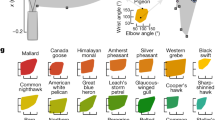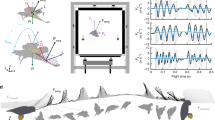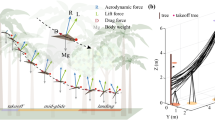Abstract
The relationship between mechanical power output and forward velocity in bird flight is controversial, bearing on the comparative physiology and ecology of locomotion1,2. Applied to flying birds, aerodynamic theory predicts that mechanical power should vary as a function of forward velocity in a U-shaped curve. The only empirical test of this theory, using the black-billed magpie (Pica pica), suggests that the mechanical power curve is relatively flat over intermediate velocities3. Here, by integrating in vivo measurements of pectoralis force and length change with quasi-steady aerodynamic models developed using data on wing and body movement, we present mechanical power curves for cockatiels (Nymphicus hollandicus) and ringed turtle-doves (Streptopelia risoria). In contrast to the curve reported for magpies3, the power curve for cockatiels is acutely concave, whereas that for doves is intermediate in shape and shows higher mass-specific power output at most speeds. We also find that wing-beat frequency and mechanical power output do not necessarily share minima in flying birds. Thus, aspects of morphology, wing kinematics and overall style of flight can greatly affect the magnitude and shape of a species' power curve.
This is a preview of subscription content, access via your institution
Access options
Subscribe to this journal
Receive 51 print issues and online access
$199.00 per year
only $3.90 per issue
Buy this article
- Purchase on Springer Link
- Instant access to full article PDF
Prices may be subject to local taxes which are calculated during checkout



Similar content being viewed by others
References
Ellington, C. P. Limitations on animal flight performance. J. Exp. Biol. 160, 71–91 (1990)
Rayner, J. M. V. Estimating power curves of flying vertebrates. J. Exp. Biol. 202, 3449–3461 (1999)
Dial, K. P., Biewener, A. A., Tobalske, B. W. & Warrick, D. R. Mechanical power output of bird flight. Nature 390, 67–70 (1997)
Rayner, J. M. V. A vortex theory of animal flight. Part 2. The forward flight of birds. J. Fluid Mech. 91, 731–763 (1979)
Norberg, U. M. Vertebrate Flight: Mechanics, Physiology, Morphology, Ecology and Evolution (Springer, Berlin, 1990)
Askew, G. N., Marsh, R. L. & Ellington, C. P. The mechanical power output of the flight muscles of blue-breasted quail (Coturnix coturnix) during take-off. J. Exp. Biol. 204, 3601–3619 (2001)
Biewener, A. A., Corning, W. R. & Tobalske, B. W. In vivo muscle force-length behavior during level flight in pigeons (Columba livia). J. Exp. Biol. 201, 3293–3307 (1998)
Pennycuick, C. J., Klaasen, M., Kvist, A. & Lindström, Å. Wingbeat frequency and the body drag anomaly: wind-tunnel observations on a thrush nightingale (Luscinia luscinia) and a teal (Anas crecca). J. Exp. Biol. 199, 2757–2765 (1996)
Tobalske, B. W. Biomechanics and physiology of gait selection in flying birds. Physiol. Biochem. Zool. 73, 736–750 (2000)
Tobalske, B. W. & Dial, K. P. Effects of body size on take-off performance in the Phasianidae (Aves). J. Exp. Biol. 203, 3319–3332 (2000)
Rosser, B. W. C. & George, J. C. The avian pectoralis: histochemical characterization and distribution of muscle fiber types. Can. J. Zool. 64, 1174–1185 (1986)
Rosser, B. W. C., Wick, M., Waldbillig, D. M. & Bandman, E. Heterogeneity of myosin heavy-chain expression in fast-twitch fiber types of mature avian pectoralis muscle. Biochem. Cell Biol. 74, 715–728 (1996)
Dial, K. P. Activity patterns of the wing muscles of the pigeon (Columba livia). J. Exp. Zool. 262, 357–373 (1992)
Thomas, A. L. R. On the aerodynamics of birds' tails. Phil. Trans. R. Soc. Lond. B 340, 361–380 (1993)
Hedrick, T. L., Tobalske, B. W. & Biewener, A. A. Estimates of circulation and gait change based on a three-dimensional kinematic analysis of flight in cockatiels (Nymphicus hollandicus) and ringed turtle-doves (Streptopelia risoria). J. Exp. Biol. 205, 1389–1409 (2002)
Pennycuick, C. J., Alterstam, T. & Hedenström, A. A new low-turbulence wind tunnel for bird flight experiments at Lund University, Sweden. J. Exp. Biol. 200, 1441–1449 (1997)
Acknowledgements
We thank G. Lauder and F. Jenkins Jr for comments on this work, and the Concord Field Station staff for animal care and help with experiments. This work was supported by grants from the National Science Foundation to A.A.B. and K.P.D., and from Murdock to B.W.T.
Author information
Authors and Affiliations
Corresponding author
Ethics declarations
Competing interests
The authors declare that they have no competing financial interests.
Rights and permissions
About this article
Cite this article
Tobalske, B., Hedrick, T., Dial, K. et al. Comparative power curves in bird flight. Nature 421, 363–366 (2003). https://doi.org/10.1038/nature01284
Received:
Accepted:
Issue Date:
DOI: https://doi.org/10.1038/nature01284
This article is cited by
-
Investigation of the rate-mediated form-function relationship in biological puncture
Scientific Reports (2023)
-
On the role of tail in stability and energetic cost of bird flapping flight
Scientific Reports (2022)
-
Costs and benefits of social relationships in the collective motion of bird flocks
Nature Ecology & Evolution (2019)
-
Birds repurpose the role of drag and lift to take off and land
Nature Communications (2019)
-
Gravitation-enabled Forward Acceleration during Flap-bounding Flight in Birds
Journal of Bionic Engineering (2018)
Comments
By submitting a comment you agree to abide by our Terms and Community Guidelines. If you find something abusive or that does not comply with our terms or guidelines please flag it as inappropriate.



